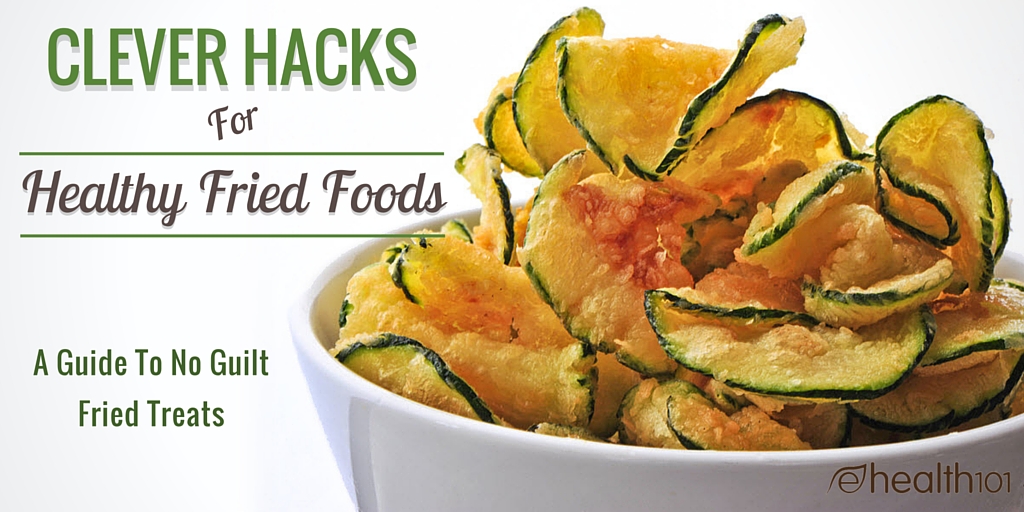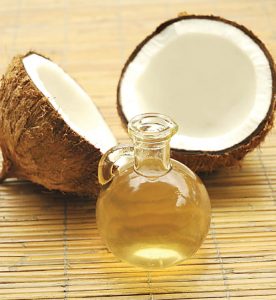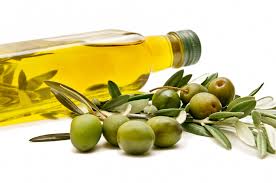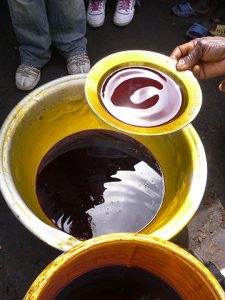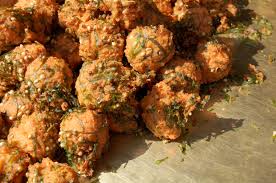If there ever comes a time in my life in which I have to choose a last meal, it’s probably going to consist mainly (if not solely) of deep fried food. My love for greasy goodness is unlike any other. Some people are all about their sweets – they love a good cookie, a fluffy piece of chocolate cake, or a fruit filled pie. And that’s cool – you should absolutely enjoy those things once in a while because life’s too short – but I’m far more impressed by a good poutine or plate of deep fried pickles with ranch sauce for dipping.
Don’t get me wrong, it’s not something I enjoy on a daily basis but I do indulge every once in a while. And while eating fried foods is still a far cry from eating a salad on the healthy scale, I bet you didn’t know that fried foods don’t have to be as awful as you think. I mean, you’re never going to be able to go out to a commercial restaurant and expect to get high quality fried food, but as long as you’re at home and you have a deep fryer (preferably, although I read that you can also use a pot), you can make relatively healthy fried foods for much less.
Here’s What Matters
 The Temperature Of The Oil
The Temperature Of The Oil
Here’s why I prefer the deep fryer method – To cook your food properly, the oil has to sit on average at a temperature of 350-375 degrees. If your oil isn’t hot enough, your food is going to soak up more oil than it should and end up being way too greasy; if it’s too hot and goes beyond its smoke point it’s going to start breaking down and releasing free radicals and a bunch of other nastiness into your (too dry and possibly burnt) food. When the temperature is just right, you end up with a perfectly crispy outer layer that’s exquisitely steamed on the inside.
Most modern deep fryers (any one I’ve ever seen, anyway) are able to be set to a specific temperature. As long as you’re sure that your gauge is in good working condition (it should be as long as you keep it clean and it’s relatively new), I feel they’re the best method for keeping a consistent temperature and helping to prevent oxidation of the oil (they’re also much safer). If all you have is a pot on hand to do your frying, remember to keep a very close eye on it and use a thermometer to keep a consistent temperature.
The Smoke Point Of The Oil
Before we wrap up, we’re going to discuss various oils and their smoke points, but here’s a quick explanation of why the smoke point of your oil is important – The higher the smoke point, the more resistant the oil is to oxidation. The higher the temperature your oil is able to take, the less likely is it to release a bunch of gross stuff into whatever it is you’re cooking.
A more stable oil might cost a little more than the cheap vegetable oil that most people keep in their home deep fryers, but I think your good health is worth the small investment, don’t you?
And How Fresh It Is
I used to change my oil once a month or so (being someone who used it maybe once or twice a week at the time), and even that was more than most people I know (think about how much commercial oil is reused and heated; another reason to steer clear of most takeout). The more your oil is exposed to the air and high temperatures, the more readily it’ll break down.
Needless to say, I now change my oil just about every time I use it (if I’m feeling lazy I’ll use it twice). Again, it’s a little more expensive to do it this away but definitely worth it.
What Oils To Use
We’ve already discussed which oils you should steer clear of, but we didn’t really get into which oils you should use instead. Here’s a pretty complete list, including smoke points:
 Coconut Oil
Coconut Oil
Coconut oil is one of those things that really can be classified as a superfood. This stuff is super good for you inside and out, and it can be used in a million different ways; so it makes perfect sense that this would make the top of the list for frying oils.
Since more than 90% of the fats in this oil are saturated, it’s incredibly heat resistant (learn more about PUFAs in the above-linked article). This study shows that even after 8 consecutive hours of deep frying at 365 degrees, its quality did not deteriorate. Some brands may leave a slight scent or flavor on the foods you cook in them, so if you’re not a fan of the taste of coconut, you might want to fry your foods in one of the other items on this list.
Drippings, Lard, Or Ghee
Ghee is incredible for your health, and one day soon I hope to get around to writing an article on just how good it is. Basically, it’s classified as clarified butter and since butter itself isn’t exactly the best thing to use for frying your foods (it has carbs and proteins in it that burn when they’re heated up) it’s the perfect way to get the buttery taste safely.
Lard, tallow, and fat drippings are also an excellent choice as long as they come from a proper source – Organic, pasture raised/grass fed drippings are what you want. Grain fed animals have a lot more polyunsaturated fats (…antibiotics, hormones, other grossness, etc.) in them which makes them as useless as vegetable oil. You can usually buy lard and tallow at your local butcher (possibly even at your grocery store if you live in the right area).
 Olive Oil
Olive Oil
Olive oil is one of the healthiest oils on the planet, and it has almost as many uses as coconut oil does. You probably already use it to add depth to your salads, but you probably never even thought you could fry in it. You definitely should! Olive oil is incredibly high in monosaturated fats, which are heat resistant as well.
This study found that you can fry in olive oil for more than 24 hours straight before it begins to excessively oxidize (and really, when are you ever going to need to fry food for more than 24 hours?).
Avocado Oil
This oil is also made up of mostly monosatuated fats, and I’m a pretty big fan of its nutty scent and slight flavour. If you can get your hands on some avocado oil (at a health food store, possibly your grocery store, or – as a last resort – online), I strongly suggest you do so. It has a smoke point of 520 degrees, so you can rest easy knowing that you’re nowhere near burning it if you’re using a modern deep fryer.
 Palm Oil
Palm Oil
This one isn’t necessarily the best one on the list (especially because of all the sustainability/environmental concerns surrounding it), but it’s probably the most accessible. It consists of mostly saturated and monosaturated fats and doesn’t leave any sort of taste of fragrance on your food as long as it’s fresh. If you decide to use palm oil for your frying needs, go with unrefined (red palm oil) – As always, the less processing something has gone through the better it is for you. Use it if you absolutely can’t get your hands on anything else.
Make It Healthier
Now that you know which oils are best to use, here are some extra tips that you can use to make your fried food even healthier:
Add Some Carbonation To Your Batter
A good chunk of the appeal of fried foods is the batter. When done right, the batter can help add texture, density, and flavour to whatever the food it, when it’s done wrong it can be a big greasy mess of yuck. A handy trick is to add a carbonated liquid or some baking soda to your batter before you throw your food in the oil – This releases gas bubbles when it heats up and helps prevent your food from being too greasy.
Use A Gluten Free Flour
This is going to be a given to anyone that has celiac disease or another gluten sensitivity, but using a gluten free flour can help make your batter a little healthier even if you don’t have any issues – All purpose flour works great and all, but it can also absorb a lot more oil than some of its gluten free counterparts.
Cornmeal is my personal go-to, but I’ve also had success with rice and coconut flours. I actually prefer the cornmeal and baking soda combination to a traditional batter now, the fact that it’s better for me is just another bonus!
 Experiment With Different Things
Experiment With Different Things
There’s more to the deep fried world than potatoes, fish, and chocolate bars. Of course you can make your own onion rings, but it expands even further than that – You’d be surprised by just how good Brussel sprouts are when they’re breaded and fried, and don’t even get me started on the goodness of fried cauliflower…
The point is, you should play around with it a bit; fried vegetables are still vegetables, they’re still going to be good for you (just not near as good for you as they could be if they were say, steamed).
Other fried veggies I absolutely love and are ‘approved’ by my family as well (very important if you don’t cook just for yourself) include zucchini, eggplant and sweet potatoes. My next experiment: deep fried pickles!
And Don’t Forget The Paper Towels
I know that you want to eat your food as soon as it comes out of the deep fryer. But not only is it piping hot at that point, it also has a lot of excess grease on it (that – if left to dry – could make your food taste a lot greasier than you intend).
To get rid of that grease, all you need to do is throw your food on some paper towels and let it sit there for a minute or two to soak it up.
Obviously, there are a ton of other cooking methods – steaming, sautéing, roasting, etc. – that are considered to be healthier than frying, but if you’re living an overall healthy lifestyle – You do your best to eat well and exercise on a regular basis – there’s absolutely no reason whatsoever to not indulge in a treat every once in a while. If you use the right kinds of batters and oils – Regardless of whether you’re frying, baking, or roasting – even your indulgences can provide you with stuff that you need.
If you have high cholesterol or another condition that requires you to limit the amount of fat in your diet, please consult with your medical or holistic professional before frying any type of food. Even though these oils are made up of fats that are good for you, I’m not a doctor nor do I know your specific conditions – Make sure that these changes are okay with someone that does.
